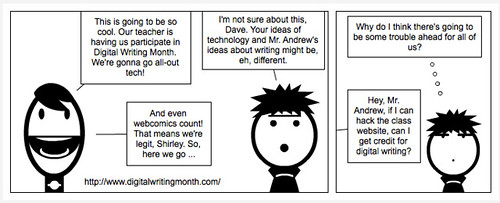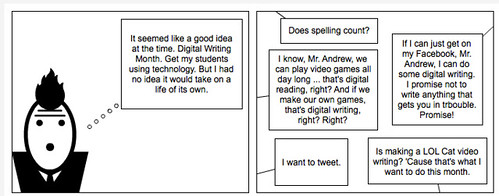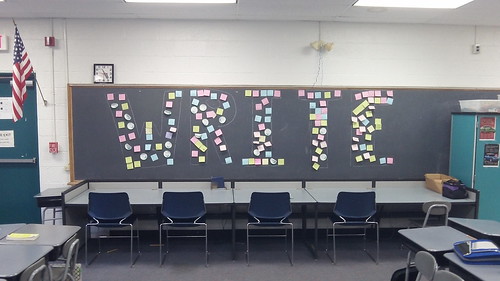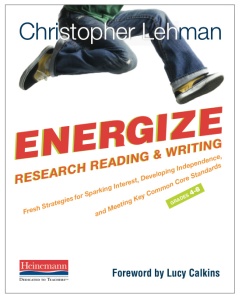Have you been following the ongoing series of posts at The Atlantic Magazine on the theme of writing?
I’ve been back and forth over the past few weeks as the magazine first featured a controversial but very insightful article about a turnaround school that focused its writing curriculum almost solely on expository writing and grammar instruction. This was spurred on by poor test scores and the admission that its students were struggling to write even complete sentences. What the real theme of the series centers around, it seems to me, is the role and balance of creative, narrative writing and expository information writing — which really drives into the heart of the discussion of the Common Core. The first article by Peg Tyre kicked off a series of other posts about the craft of teaching writing with students, and the pieces have been very interesting to read and think about.
I take my hat off to Cindy O’Donnell-Allen (a National Writing Project colleague) who argued that teachers need to be writers, and viewed as writers, for students to really take writing seriously as a means of expression. And there have been insightful pieces about the creative process (about developing strategies for ideas) and the need for poetry in the curriculum to nurture logical thinking, and how organizations like Dave Eggers’ Valencia 826 writing centers have energized and supported young writers.
And a high school student even responded with a fantastic piece of writing, talking about how some of her best teachers have shown her how to see her own writing through various lenses.
And then there are the two technology-related pieces that caught my attention.
The first piece talks about how teachers need to start envisioning the assessment and support of student writing with technology as a tool. The notes in the margins to students rarely get read. What if our time was spent more wisely, the authors write, in the early stages of writing, conferring directly with students (or outside of class, with online conferences) and using the technology tools to help with the grammar and syntax. The authors also suggest that the advent of software to read essays might be one of those tools. I’m still not sure about that.
The second piece makes interesting connections between traditional writing skills and programmers creating code, and ponders the question of whether software would be less buggy and more innovative if programmers had better writing skills. He notes that documentation of software is often a mess, and that writing focuses a person on logic, and sequence, and clarity.
I also appreciated that Tyre came back after those other articles were posted, and responded with another insightful piece, arguing again about the need for balance. Of course, if you look at how The Atlantic frames the series — with the overarching title of Why American Students Can’t Write, you get a sense of rhetorical stance via writing, right? The unspoken answer is that students can write because teachers can’t teach writing. Or don’t.
Here’s how Tyre ends the series:
What I have seen in my many years writing about education is that teaching creative writing in place of the mechanics of writing is a disaster for children at the other end of the economic spectrum. Many enter high school unable to write a coherent paragraph. At the tender age of 16 or so, at a time when affluent children are thinking about SAT prep classes and service projects in warm countries, it becomes obvious to some underserved students that they have not acquired the ability to reflect, analyze, and dissect ideas in writing – a set of skills that will enable them to persist through high school English and history and into college.
Others, unable to keep up, simply become bored, disengaged, and academically disconnected. They drop out and, if they are lucky, begin working a job or series of part-time jobs for hourly wages behind fast food counters, in retail, in a garage, or for a cleaner or landscaper. At the end of the workday, the conditions of their employment often causes parts of their bodies to ache.
I suggest to you that these young people needed more from their teachers than inspiration and a safe space. All students should have a chance to write poetry in school. But all students need the opportunity to gain the basic skills that will allow them to move forward in school and make a decent life for themselves and their children. Shame on us if we fail to provide that.
Peace (in the writing),
Kevin






